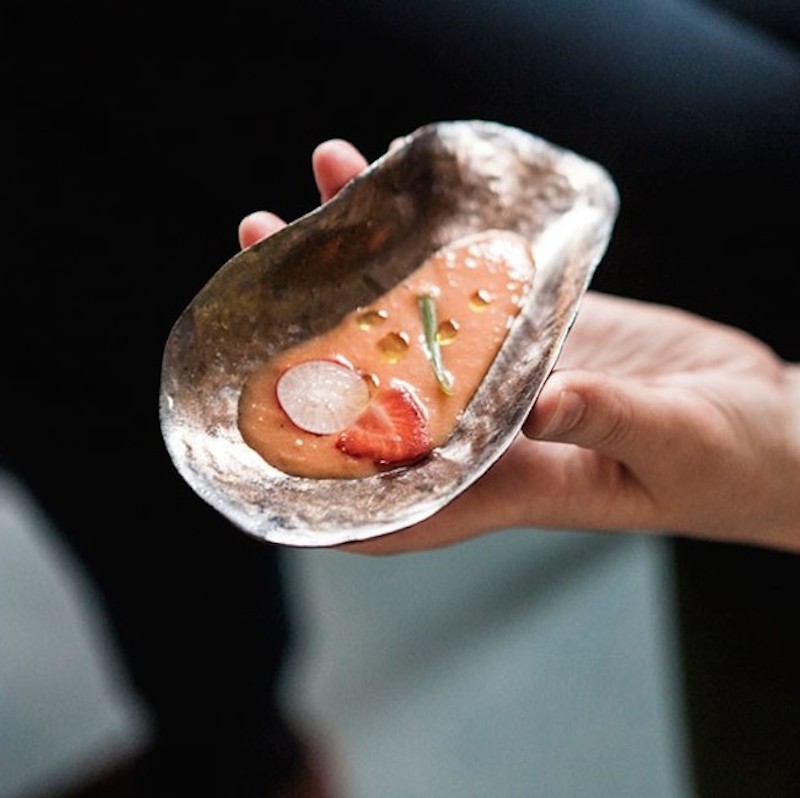AMSTERDAM — It’s been about two years since Marije Vogelzang, head of the Food Non Food Department at Design Academy Eindhoven said, “there is so much wrong with food” and there is a “food revolution” coming up. A year after she said that the Academy based an entire design show around coprophagia. Granted, Vogelzang said the concepts behind her department would be “almost impossible to grasp,” but if that’s the revolution she was speaking of I’d be happy to eat Burger King until my inevitable heart attack.
While her contemporaries at the Academy were going full-on Salò, Academy graduate Sarah-Linda Forrer was making something that changes up the ritual of eating. Evoke is a collection of eating tools. I’m sorry if that sounds overly-clinical but it’s hard to characterize them with terms like “plate” or “silverware,” they’re both and neither. Crafted in stoneware, the soft shapes are a “stage for food,” the designer says. Her goal was to create something that tapped into the intuition of eating. I like that I can immediately understand how to use the tools, but they also demand more of my attention. This means that eating becomes less of a passive activity and it is more likely to be pleasurable.
While writing this, I was reminded again of how much of the dialogue about food is built on anxiety. Even a set like this, which I think speaks for itself, comes with a manifesto. But Forrer starts in anxiety and comes around to a poetic answer for it. It’s a much better approach than the health clickbait that shows up on my Facebook feed and a hell of a better approach than Vogelzang’s. When Vogelzang says “there is so much wrong with food,” I wonder if the problem may actually be our relationship to food. It’s splitting hairs, but I wonder if the problem is that we lack a sense of control over why and how we eat. You can’t change the industry, but you can change yourself. Doing that reclaims the agency you crave. That logic is present in Evoke.
“In a world where the food system is so complicated that I no longer know where my food comes from and how it is produced, I feel the longing for a new relationship with what we eat…
“The organic shapes invite us to use the tools in our own, singular way. They become an extension of our hands and fingers, literally bringing us closer to what we eat. Contrasting with the conventional way of eating with fork, knife and plate, a family of shapes and sizes can be used in various ways to present and enjoy our food.”
The collection of seven tools was part of a successful crowdfunding campaign and Forrer says production will begin soon.
Forrer graduated from Design Academy Eindhoven in 2013, according to her biography. She was born and raised in the French Pyrenees and currently works out of Amsterdam. She states that she is fascinated by trends and eating rituals and she seeks to use her knowledge of those to influence people’s daily lives.
Bill Rodgers is the Managing Editor of cfile.daily.
Do you love or loathe this use of contemporary ceramics? Let us know in the comments.





In our fast food culture we have forgone the multiple layers of civil cutlery & fine china to simply eat most directly with our hands, once in a while a sensual gluttonous experience. What I love about culinary ware is that it can be as complicated or base as you would like it to be. Forrer’s work here slides between the pre-pottery use of shells as tools by ancient ancestors and a self aware chic dining experience. I always find it interesting when “pottery” influences behavior and with her culinary ware one would need to make conscious choices in the ritual of eating that would locate the actor somewhere on the scale between very primitive and very elegant.
The Japanese have what I always thought was a very important verb, Anshin Suru and as it applies to pottery means to make aesthetic / functional ceramics that somehow creates a sense of subliminal comfort or well being when the user employ’s it, a complex, thoughtful and important gesture as it relates to the totality of a dining experience in Japan.
Forrer’s work creates more anxiety than comfort. However in a western context, I think it works in her favor as the experience of understanding how to engaging food with her tools would heightened the moment.
My last thought is that the heavy metallic surfaces, while beautiful, make me nervous in ways that I do not want to be when eating and the alternative all white surfaces, the quick go to solution, is too easy and needs some work. However, I do think the idea is special.